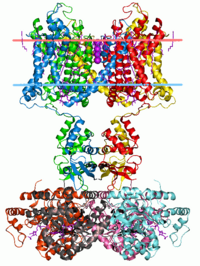
Photo from wikipedia
Peptide toxins that adopt the ShK fold can inhibit the voltage-gated potassium channel KV1.3 with IC50 values in the pM range and are therefore potential leads for drugs targeting autoimmune… Click to show full abstract
Peptide toxins that adopt the ShK fold can inhibit the voltage-gated potassium channel KV1.3 with IC50 values in the pM range and are therefore potential leads for drugs targeting autoimmune and neuroinflammatory diseases. Nuclear magnetic resonance (NMR) relaxation measurements and pressure-dependent NMR have shown that, despite being cross-linked by disulfide bonds, ShK itself is flexible in solution. This flexibility affects the local structure around the pharmacophore for the KV1.3 channel blockade and, in particular, the relative orientation of the key Lys and Tyr side chains (Lys22 and Tyr23 in ShK) and has implications for the design of KV1.3 inhibitors. In this study, we have performed molecular dynamics (MD) simulations on ShK and a close homologue, HmK, to probe the conformational space occupied by the Lys and Tyr residues, and docked the different conformations with a recently determined cryo-EM structure of the KV1.3 channel. Although ShK and HmK have 60% sequence identity, their dynamic behaviors are quite different, with ShK sampling a broad range of conformations over the course of a 5 μs MD simulation, while HmK is relatively rigid. We also investigated the importance of conformational dynamics, in particular the distance between the side chains of the key dyad Lys22 and Tyr23, for binding to KV1.3. Although these peptides have quite different dynamics, the dyad in both adopts a similar configuration upon binding, revealing a conformational selection upon binding to KV1.3 in the case of ShK. Both peptides bind to KV1.3 with Lys22 occupying the pore of the channel. Intriguingly, the more flexible peptide, ShK, binds with significantly higher affinity than HmK.
Journal Title: Journal of chemical information and modeling
Year Published: 2023
Link to full text (if available)
Share on Social Media: Sign Up to like & get
recommendations!